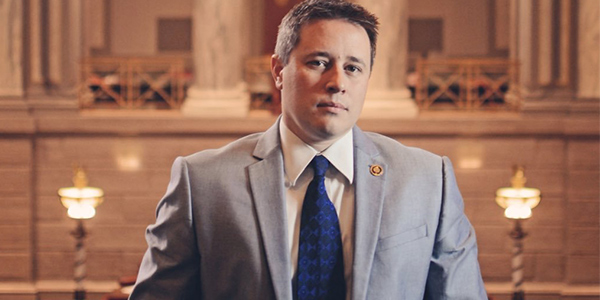Strategically placed transmission or storage devices could serve as a reliability tonic to the middle of the country, according to panelists last week during the Midwest Reliability Organization’s annual reliability conference.
Missouri Public Service Commissioner Ryan Silvey said states like his will need more transmission to reliably transition to cleaner resources. Missouri historically preferred to build coal-fired baseload generation close to load, he said, but that paradigm is quickly changing. Coal generation has dropped to a 73% share of the state’s net generation, down from a peak of 81% a few years ago.
“We’re being shaped by renewable energy mandates, pressure from customers … and aging baseload generators,” Silvey said during the virtual conference Wednesday.
He said the state’s utilities are positioned to blow past the 15% renewable portfolio standard set to take effect in January.
“This is just happening from market pressures,” he said.
Missouri also has naturally low solar and wind generation potential, Silvey said.
“We will likely need to rely on generation sources outside of Missouri,” he said, adding that the state will likely need more transmission investment to tap into other states’ resources.
“Building those needed economic transmission projects has proven to be challenging,” Silvey said. He said Missouri’s position on the MISO–SPP seam adds extra obstacles to transmission construction because of the RTOs’ competing interests.
A lack of MISO-SPP interregional transmission projects resulted in unintended consequences during MISO South’s January 2018 maximum generation event. Unusually cold weather had the RTO scrambling to send power to the region and left SPP’s Neosho-Riverton flowgate on the Kansas-Missouri border at its limit, ultimately resulting in uncontrolled loop flows in the area.
“Utilities actually had to disconnect to protect themselves from impacts,” Silvey said. “What’s going to happen when that flowgate gets another 300 MW of wind?”
Silvey stressed that for reliability’s sake, MISO must find a way to increase transmission capacity between its Midwest and South regions beyond its existing subregional transfer limits of 3,000 MW southbound and 2,500 MW northbound.
“MISO can’t really optimize and utilize all of its generation,” Silvey said. “Missouri is stuck in the middle. … We’re basically caught in the crossfire.”
MISO and SPP this year conducted a fourth coordinated system plan, a joint study that could have resulted in the RTOs’ first interregional transmission project. However, early results indicate that the RTOs failed to identify a beneficial cross-border project. (See MISO, SPP Staff Recommend 2020 Joint Study.)
Silvey called the 10 flowgates the RTOs studied this year — including Neosho-Riverton — a “canary in the coal mine.”
“Congestion is no longer limited to the hottest days of summer,” and renewables will accelerate that change, he said.
Silvey urged members, states and RTOs to “remove the red tape” and collaborate more on interregional projects.
The Case for Storage
NextEra Energy Resources’ Jeff Plew said that until 2017, batteries were mostly pilot and niche projects. But now, he said, they’re rapidly becoming the grid’s “Swiss Army knives.”
“The gist of it is they can do a lot of things,” he said. “Now, they can’t do things at the same time. You can’t use the scissors and the nail file at the same time, but you can switch rapidly between [functions].”
Plew cited batteries’ near instantaneous response time, their ability to provide real or reactive power, their chameleon-like ability to act as either generation or load, their zero start-up costs, the relative ease of siting and their modular nature that makes them easy to scale up.
He also said batteries tend to perform better than conventional generation during extreme cold weather conditions, with inverters rated for temperatures as low as -40 degrees Celsius.
“Continued cost declines have made batteries a compelling alternative to traditional fossil-fueled peaker options in meeting flexible capacity needs,” Plew said.
Carbon-free mandates in several U.S. cities and decarbonization goals mean that storage must become a vital piece of markets in the next 20 to 30 years, he said. “Storage has got to be a significant piece of the puzzle here.”
American Transmission Co. Senior Transmission Planning Engineer Randy Johanning said his company’s $8 million Waupaca area energy storage project is poised to fend off reliability issues in central Wisconsin.
The 2.5-MW/5-MWh battery project — which is MISO’s first storage-as-transmission project — has been on hold because the RTO didn’t have FERC Greenlights MISO Storage-as-Tx Proposal.)
The project is expected to be in service by the end of 2021. MISO and FERC predict storage-as-transmission solutions will most likely solve transmission reliability needs.
“We did consider traditional wires solutions here,” Johanning said, adding that the storage solution avoids the need for a more “invasive” rerouting of lines and additional rights of way.
He also said the project presents less financial risk than transmission lines that must be financed over 40 years and whose usefulness is dependent on nearby generation. He said battery storage’s current 20- to 25-year lifespan becomes less of a drawback when considering that ratepayers won’t have the costs reflected in their bills for decades.
Johanning advised that utilities thinking of using storage should focus on which specific issue they are trying to solve, taking pains to size and site their storage carefully.


